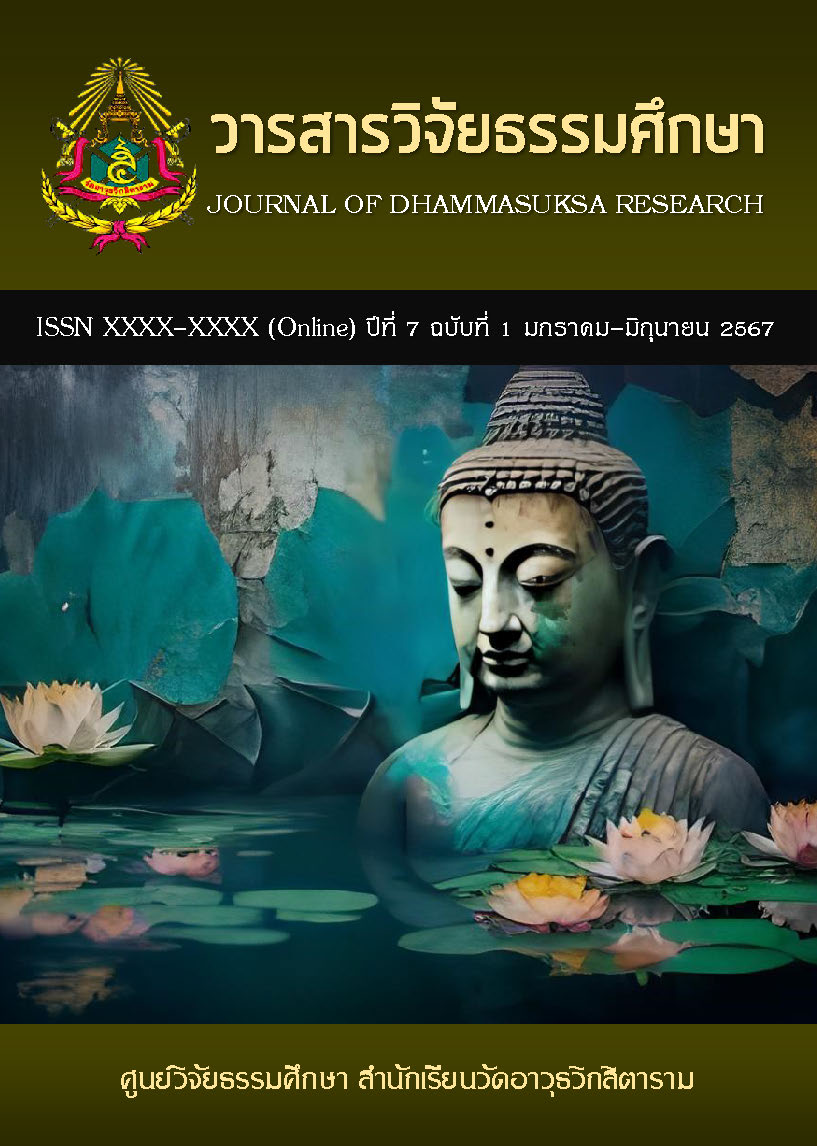THE SERVANT LEADERSHIP MODEL FOR ADMINISTRATORS OF ART AND DESIGN COLLEGES IN BEIJING METROPOLIS
คำสำคัญ:
Servant Leadership Model, Administrators, Art and Design Colleges, Beijingบทคัดย่อ
The objectives of this research were: (1) To determine the components and indicators of Servant Leadership for Administrators; (2) To develop the model of Servant Leadership for Administrators of art and design colleges in Beijing Metropolis.
The research was a mixed methodology, including qualitative and quantitative research. The population of the research consisted of 7,174 who were teachers of art and design colleges in Beijing Metropolis. A proportional stratified random sampling method was used to sample, totaling 418 persons. The instruments used for data collection were semi-structured interview and a five-level rating scale questionnaire. The statistics used for data analysis were descriptive statistics and Confirmatory Factor Analysis.
The research findings revealed that: (1) there were 7 components and 27 indicators of servant leadership for administrators of art and design colleges in Beijing Metropolis, which consisted of Empathy / Trusting, Trust, Credibility / Empowerment, Authorization / Altruism / Vision, Foresight / Listening / Service; and (2) the developed servant leadership model for administrators of art and design colleges in Beijing Metropolis was consistent with the empirical data. The value of Relative Chi-square (χ2/df) = 1.012, Chi-square (χ2) = 318.749, Degree of Freedom (df) = 315, p-value = .430, Goodness of Fit Index (GFI) = 0.946, Adjusted goodness of fit index (AGFI) = 0.936, Tucker-Lewis Index (TLI) = 1.00, Root Mean Square Error of Approximation (RMSEA) =0.005, all in line with specified criteria. And the key components had the weight between 0.96-1.00 higher than 0.70.
เอกสารอ้างอิง
Autry, J. (2001). The Servant Leader: How to Build a Creative Team, Develop Great Morale, and Improve Bottom-Line Performance. New York: Three Rivers Press.
Barbuto Jr, J. E., & Wheeler, D. W. (2006). Scale development and construct clarification of servant leadership. Group & Organization Management, 31(3): 300-326.
Blanchard, K. (2003). The Servant Leader. San Francisco: Berrett-Koehler Publishers.
Blanchard, K., Zigarmi, P., & Zigarmi, D. (2013). Leadership and the One Minute Manager. New York: William Morrow.
Chen, Y., & Zhu, Y. (2018). Servant leadership: A Confucian perspective. Journal of Business Ethics, 152(1): 83-95.
Dong, Y., Yang, F., & Zhang, Q. (2018). Servant leadership and employee creativity: The mediating role of trust in leader. Journal of Business Research, 89: 292-299.
Ferch, S. R., & Spears, L. C. (Eds.). (2018). Servant Leadership: Developments in Theory and Research. New York: Palgrave Macmillan.
Greenleaf, R. K. (1977). Servant leadership: A journey into the nature of legitimate power and greatness. Paulist Press.
James B. Laub (1999). The Essence of Servant Leadership Author: Leadership & Organization Development. Journal Volume, 20 (4): 205-214.
Jaworski, J. (1996). Synchronicity: The Inner Path of Leadership. San Francisco: Berrett-Koehler Publishers.
John W. Best, James V. Kahn Published by Allyn & Bacon. (1997) Research in Education (8th Edition), 190.
Jöreskog, K. G. & Sörbom, D., (1993). LISREL 8: User’s Reference Guide. Chicago, IL: Scientific Software International, Inc,.
Laub, J. A. (1999). Assessing the servant organization: Development of the Servant Organizational Leadership Assessment (SOLA) instrument. Dissertation Abstracts International, 60(02): 0033.
Lencioni, P. (2016). The Ideal Team Player: How to Recognize and Cultivate The Three Essential Virtues. Hoboken, New Jersey: Jossey-Bass.
Liden, R. C., Wayne, S. J., Liao, C., & Meuser, J. D. (2014). Servant leadership and serving culture: Influence on individual and unit performance. Academy of Management Journal, 57(5): 1434-1452.
Liden, R. C., Wayne, S. J., Zhao, H., & Henderson, D. (2008). Servant leadership: Development of a multidimensional measure and multi-level assessment. The Leadership Quarterly, 19(2): 161-177.
Liu Xueying. (2010). Servant Leadership Research in China: A Review and Future Research Directions.
Liu, X., & Gong, Y. (2020). Linking servant leadership to employee well-being: The role of work-family conflict and psychological capital. Journal of Business Ethics, 164(3): 527-541.
Page and Wong. (2000). Servant Leadership: A Journey into the Nature of Legitimate Power and Greatness.
Patterson K. (2003). Servant leadership: A theoretical model[D]. Virginia Beach: Regent University.
Russell R F. (2001). The role of values in servant leadership[J]. Leadership & Organization Development Journal, 22(2): 76-83.
Sendjaya, S., & Sarros, J. C. (2002). Servant leadership: Its origins, development, and application in organizations. Journal of Leadership & Organizational Studies, 9(2): 57-64.
Senge, P. M. (1990). The Fifth Discipline: The Art and Practice of the Learning Organization. New York: Currency Doubleday.
Sinek, S. (2014). Leaders Eat Last: Why Some Teams Pull Together and Others Don't. New York: Portfolio.
Spears, L. C. (2010). Character and servant leadership: Ten characteristics of effective, caring leaders. The Journal of Virtues & Leadership, 1(1): 25-30.
Stone, A. G., Russell, R. F., & Patterson, K. (2003). Transformational versus servant leadership: A difference in leader focus. Leadership & Organization Development Journal, 25(4): 349-361.
Sun Jianmin and Wang Biying. (2010). An Empirical Study on the Dimensions of Servant Leadership in Chinese Context.
Van Dierendonck, D., & Nuijten, I. (2011). The servant leadership survey: Development and validation of a multidimensional measure. Journal of Business and Psychology, 26(3): 249-267.
Wang Chunxiao, Ling Qian, Zhang Xiujuan. (2009). Design and test of the public servant leadership scale of Chinese enterprises [fJ}. Nankai Management Review, 12(3): 94-103.
Wang, H., Zhang, Y., & Hu, Y. (2019). Servant leadership and employee creativity in China: A moderated mediation model. International Journal of Human Resource Management, 30(9): 1408-1430.
Washington R R, Sutton C D& Field H S. (2006). Individual differences in servant leadership: the roles of values and personality. Leadership & Organization Development Journa1, 27($): 700-716.
Wu, H., & Huang, X. (2020). Servant leadership in China: A review and research agenda. Journal of Business Research, 116: 387-396.
Zhang, J. J., & Gong, T. (2018). Servant leadership in China: A case study of Haier. Asia Pacific Journal of Management, 35(1): 55-75.
ไฟล์ประกอบ
เผยแพร่แล้ว
รูปแบบการอ้างอิง
ฉบับ
ประเภทบทความ
หมวดหมู่
สัญญาอนุญาต
ลิขสิทธิ์ (c) 2024 วารสารวิจัยธรรมศึกษา

อนุญาตภายใต้เงื่อนไข Creative Commons Attribution-NonCommercial-NoDerivatives 4.0 International License.



